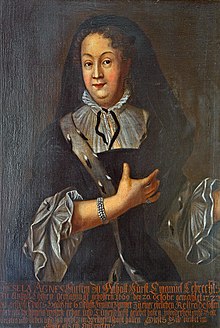Gisela Agnes von Rath
Gisela Agnes von Rath (born October 9, 1669 in Kleinwülknitz ; † March 12, 1740 in Nienburg ) had been Countess of Nienburg since 1694 and Princess von Anhalt-Köthen , who ruled as guardian for her son from 1704 to 1715, from 1692 by marriage .
Life
Gisela Agnes came from an old Lutheran noble family. Her parents were Balthasar Wilhelm von Rath , heir to Kleinwülknitz , and Magdalene Dorothee von Wuthenau . Her grandfather was Wilhelm von Rath , commander of the Anhalt-Köthen troops in the Thirty Years' War under Prince Ludwig I of Anhalt-Köthen .
As a young prince, the future Prince Emanuel Lebrecht von Anhalt-Koethen (1671–1704) fell in love with Gisela Agnes. His mother, Princess Eleonore, initially tried to prevent this improper relationship by sending Gisela Agnes to her sister in Stadthagen . Immediately after taking office, Prince Emanuel Lebrecht brought her back and married her "in silence" on September 30, 1692.
The secretly performed morganatic marriage of the Reformed prince to a Lutheran woman from the lower nobility sparked vehement protests on the part of the Reformed Church and the Princely House. It was not until 1698 that all male descendants of the couple were officially recognized by the Anhalt princes; the imperial confirmation followed in 1699. The entire princely, later ducal line of Anhalt-Köthen stems from this "improper" love marriage.
Reign
Her husband had appointed her regent in guardianship of her son Leopold von Anhalt-Koethen while she was still alive . After Emanuel Lebrecht's death in 1704, she therefore took over the reign of the country. She promoted the interests of her Lutheran co-religionists and founded Koethen's first Lutheran house of worship, the St. Agnus Church (1694–99), to which Johann Sebastian Bach was to belong only a few years later . Another foundation of the princess was the noble ladies monastery, later Gisela-Agnes-Stift (1711). Formally under her reign, but financed by her son Leopold, a court orchestra was founded in 1714, mainly from members of the Berlin court orchestra, which had been dissolved in the previous year. The first Kapellmeister was the opera composer Augustin Reinhard Stricker , who was replaced three years later in 1717 by Johann Sebastian Bach.
As early as 1694, Emperor Leopold I had raised Gisela Agnes to the rank of “Countess of Nienburg”, and in 1699 Emanuel Lebrecht left her town, country and Nienburg Castle (Saale) as personal property for life. When her son Leopold took office in 1715, she therefore withdrew to Nienburg, where she lived in the former Nienburg monastery . She continued to actively represent the interests of her Lutheran co-religionists against the Reformed Protestantism represented by her sons. She also got in touch with the theologian and educator August Hermann Francke , who even visited her here at her widow's residence.
Her daughter Eleonore Wilhelmine and Duke Ernst August I of Saxe-Weimar married on January 24, 1716 in Nienburg . It is believed that Leopold first met Bach on this occasion.
Gisela Agnes died in Nienburg on March 12, 1740 and was buried in the princely crypt of the St. Jakobskirche in Köthen . Her huge portrait of the founder of Antoine Pesne (1713) still adorns St. Agnus Church in Köthen today.
literature
- Paul Ehrhardt: Gisela Agnes - Bach. Pictures from Köthen's past. Koethen 1935
- Thorsten Heese: Gisela Agnes von Anhalt-Köthen, b. von Rath - the princess mother of the Bach patron , in: Cöthener Bach-Hefte , 10 (2002), 141-180
- Friedrich Heine: News about Gisela Agnes. Cöthen 1913 (Contributions to Anhalt history, issue 18)
- Gottlieb Krause : A letter from Prince Leopold zu Anhalt-Dessau to the widowed Princess Gisela Agnes zu Anhalt-Köthen , in: Mitteilungen des Verein für Anhaltische Geschichte 1 (1877), 482 ff.
- Katrin Rawert, regent and widow. Temporal rule and the relationship between Gisela Agnes von Anhalt-Köthen and her children, in: Eva Labouvie (Hrsg.), Adel in Sachsen-Anhalt. Court culture between representation, entrepreneurship and family, Cologne 2007, pp. 49–77.
- Stefanie Walther, "Energetic mother" or "plague"? Noble widows and their location within the family association, in: Ulrike Ilg (Ed.), Princely Widows in the Early Modern Age. On the art and cultural history of a stand, Petersberg 2015, pp. 27–39.
fiction
- Friedrich Heine: Gisela Agnes, a cultural-historical novel. Cöthen: Schettler 1909.
| personal data | |
|---|---|
| SURNAME | Rath, Gisela Agnes from |
| BRIEF DESCRIPTION | Regent of the Principality of Anhalt-Köthen |
| DATE OF BIRTH | October 9, 1669 |
| PLACE OF BIRTH | Koethen-Kleinwülknitz |
| DATE OF DEATH | March 12, 1740 |
| Place of death | Nienburg |

